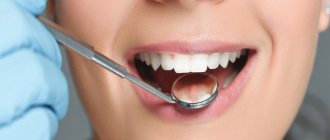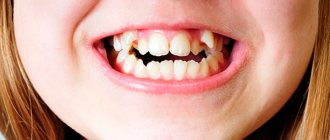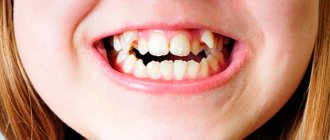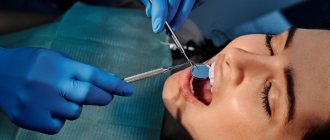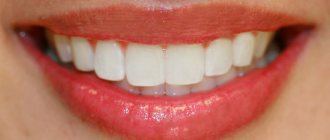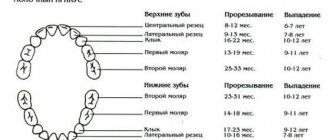Alexander Spesivtsev, orthodontist Hello everyone. It often happens that bad habits in children, characteristic of infancy and younger age, remain with them until the beginning of school and beyond. Naturally, it is very strange for everyone around to look at a first-grader child who still holds foreign objects in his mouth... In our and many other cases, it is the “FINGER”, which simply “remarkably” forms an open bite in children.
Finger in mouth causes open bite
Such things are not uncommon and blaming parents is not always correct. The reasons for such a habit as thumb sucking are multifaceted:
- unsatisfactory sucking reflex,
- teething,
- at an older age, this is a neurological disorder; the child expresses his feelings in this way...
But by the age of 7, it becomes less important to us where and why, but how to
effectively get rid of this habit?
Because, as we see, such habits lead to disorders of bite, speech function, chewing (biting), and the aesthetics of appearance are also not up to par. For clarity, we show the case of one girl who did not give up for a long time and stubbornly and did not want to give up her “wonderful” habit! And as a result, the child has an open bite.
How to wean a child from thumb sucking?
More recently, there were, one might say, “old-fashioned” methods of getting rid of this negative habit. And to this day, some well-wishers can advise an alarmed mother in such very ambiguous ways as:
- smearing your fingers with mustard, an extract from aloe leaves, applying a bitter varnish to your nails or sprinkling your fists with pepper (the main thing is that the product has an unpleasant taste);
- restriction of movements by bandaging the fingers, putting mittens on the hands, tightly swaddling (if it comes to infants) or tying the arms to the body of older children;
- constant screams that sound every time the child puts his finger to his mouth;
- threat of punishment for trying to suck a finger or direct punishment.
Some parents consider such methods quite effective, while others point out their cruelty. For example, mustard can harm the oral mucosa.
Such restrictive measures often end in a relapse into a bad habit. As soon as parents stop tying their hands or lubricating their fingers with something bitter, the baby begins to suck even more intensely in order to calm down and restore a positive psychological attitude.
Parents should choose the most painless method for eliminating negative attachments. The most reasonable and obvious step is to find and eliminate the root cause why the baby sucks his fingers.
Up to 2 years
Usually, by the beginning of the second year of life, the sucking reflex fades away on its own. However, due to the dissatisfaction of the basic instinct in infancy, thumb sucking can become a habit. The rules for getting rid of addiction will depend on the way the child is fed.
Breast-feeding
If a baby feeding on mother's milk additionally sucks a finger, the mother, first of all, should make sure how correctly she has established the feeding of the baby. Most likely, the reason is very simple - the baby is hungry and demands his mother’s breast. What to do?
- Try increasing the duration of feeding. Let the baby stay at the breast for more than half an hour. In this case, the sucking baby will be full and satisfy basic instincts.
- If you give your baby both breasts at one meal, try offering them at regular intervals. That is, the second breast is given only after the baby has suckled the first for 25 minutes.
- There is no need to worry that your child will overeat. No matter how long he stays near his mother’s breast, he will take the amount of milk that is necessary for complete saturation.
- If your baby gets distracted by something while feeding, there is no need to cut the meal short. Wait a little, and the baby will return to his mother’s breast on his own.
If possible, wind down the feeding process gradually. At first you need to reduce the number of daytime feedings, and only then move on to night feedings. This will allow the baby to experience weaning more calmly.
Artificial feeding
If the child is an artificial person, then weaning off a bad habit will be done in slightly different ways. In the case of IV, children are fed according to a certain schedule, and a portion of the formula is dosed. What to do in such a situation?
- Reduce the intervals between meals if your baby begins to pull his fingers towards his mouth. This is a signal that he is feeling hungry.
- To fully satisfy the sucking reflex, you should purchase a pacifier that allows you to lengthen the feeding process. The device must be rigid and have a smaller hole.
- Instead of a finger, offer your child a pacifier, but to avoid harmful effects on the teeth, it is better to take an orthodontic model. It ensures the correct position of the tongue in the oral cavity and promotes the optimal structure of the incisors.
If your baby is teething, you need to purchase a high-quality teether with an additional cooling element. This device will help the child give up his fingers.
In general, expert advice regarding the habit of sucking fingers at this age comes down to satisfying the sucking reflex. Mother's breasts, a bottle with formula, or an orthodontic pacifier can come to the rescue.
From 2 to 5 years
When a baby is 2 or 3 years old, the factors that cause him to suck his thumb are no longer associated with reflexive behavior. The psychological causes of obsessive behavior are at the forefront.
Among the main reasons for the formation of a bad habit or its return, experts identify the following “catalysts”:
- dysfunctional family environment;
- strict parenting methods;
- lack of mother's attention;
- problems getting used to kindergarten;
- psycho-emotional overload;
- fears.
Before moving on to solving the problem, you need to establish its true cause. You can do this yourself by analyzing your own and your child’s behavior, or you can contact a specialist who will also tell you how to wean your baby from thumb sucking. General recommendations are:
- Pay more attention to your child. Read books, communicate, engage in outdoor games, play a small ball more often to keep children's fingers occupied. In general, give your child warmth and a feeling of security.
- Reduce emotional or intellectual stress. This is especially true for those mothers who are passionate about the idea of early education for their children. Another rule is to give up exercise in the evening, instead of playing games, introduce the ritual of bathing in the bath.
- Closer to the age of five, children develop various fears and phobias: fear of the dark, monsters, fairy-tale characters. An impressionable child strives to suck his finger and calm down. It is better to combat this reason with the help of psychologists.
- Avoid punishment, especially corporal punishment. Three-year-old children are already able to explain the reason for their behavior. In turn, they can also be told why thumb sucking is ugly and unhygienic.
If you have spent a lot of effort and have not achieved a positive result, you should contact a psychologist or psychotherapist. A specialist will help you cope with an intractable problem.
From 5 years and older
If a child sucks his thumb even after the age of five, parents should be wary. In most cases, such a habit indicates serious psychological problems that require professional intervention.
Thus, some cases of thumb sucking in school-aged and adolescent children are a manifestation of obsessive-compulsive neurosis, arising for physiological and psychological reasons (for example, due to severe stress).
To make sure that a bad habit is a symptom of this disorder, you need to pay attention to other signs. Thus, a child sucking his finger may demonstrate:
- winding hair around a finger or pulling out curls;
- biting nails or, for example, pencils;
- scratching or pinching the skin;
- obsessive cough.
Older schoolchildren often demonstrate obsessive thoughts, various ritual actions, high anxiety, various fears, and depressive mood.
Naturally, to make or exclude such a diagnosis, you need to contact a neurologist or psychiatrist. The specialist will prescribe the necessary medications and psychotherapeutic procedures - play, cognitive or art therapy.
Parents in such a situation should follow the following recommendations from specialists:
- provide a comfortable home environment;
- prevent emotional and intellectual stress, so as not to aggravate the course of the disease;
- refuse to focus children's attention on thumb sucking and other obsessive actions;
- track every change in children's behavior.
Of course, you shouldn’t scold your child for such addictions. Punishment will only intensify the manifestation of negative symptoms and lengthen the recovery period.
This is what an open bite looked like in a child aged 7
Her first year was the most unstable and difficult. Since the girl did not want to get rid of the habit and the medicinal mouthguard ended up on the pillow at night in every possible way.
A year of treatment for the girl’s bite has passed, let’s see the results
But one fine day, thanks to daily work, we defeated the BIG PHALANX
The final result of open bite treatment. Photo at 11 years old
Don't be afraid of getting used to the pacifier
It is better to give your child a pacifier on time from infancy, then he is unlikely to put his finger in his mouth. A pacifier is contraindicated in the first month of life, when breastfeeding is becoming established, and then, up to 1.5 years, it will be a good helper. Children break up with pacifiers more easily and quickly than with the habit of thumb sucking.
Choose a pacifier according to age so that it is not too big for the child. Change it in time, because the rubber gradually becomes softer, and your baby's sucking muscles become stronger. For proper development, he must suck on the breast or pacifier with little effort. Not to mention that a child can bite off soft rubber.
What is the treatment for bite treatment?
To put it “scientifically”, what we see is nothing more than an “ open bite
” - one of the most severe malocclusion pathologies in the practice of orthodontists. And this example shows well the effectiveness of solving and treating open bite pathology in children. Most often, in such cases, wearing an ELASTOPOSITIONER is prescribed - an orthodontic mouthguard for children made of medical silicone. The wearing mode for the treatment of an open bite is HOME - this is when a child, both day and night, while at home, must hold such a mouthguard in his mouth, clamping it with his teeth. Knowing the cause of such an overbite and eliminating it, we clearly show how the correction occurs. And all the above violations correct themselves!
Aesthetics and Function - these are the two most important parameters!
Now the girl is 11 years old. And so far we do not see the need for any additional treatment!!! So, the period for occlusion correction is 3 years and 1 year of passive monitoring of stability. Are you ready for this treatment for your child? Then don't wait for braces, contact us! Health to everyone, Yours Alexander Spesivtsev
Articles by Alexander Spesivtsev on the website
- A bitter experience with braces or a story about how aligners helped improve the situation
- Wisdom teeth: remove or treat?
- Protrusion of teeth. Treatment of bite protrusion with aligners
The following weaning methods give good results:
- If the child is still small - under 2 years old - try to gradually gradually reduce the frequency of sucking by gently removing the pacifier or finger from the mouth, distracting the child. Cuddling and increased attention will reduce anxiety and, as a result, the need for soothing sucking will decrease.
- The doctor may recommend the use of “replacement” nipples - a variety of vestibular plates.
- Try to gently convince your older child that pacifier or thumb sucking should be stopped or limited. If the baby has a well-developed sense of responsibility, he can overcome his addiction with the help of willpower simply by promising his parents that he will not suck.
- Use various incentives if the child voluntarily follows your requests and advice.
- Invite your child to “gift” a pacifier to another baby or small pet - after all, they need the pacifier more. Tell us how unpleasant it is for your finger when it is constantly sucked. Use other forms of play that involve voluntarily giving up the pacifier or giving up the finger.
- Wrap your finger in a bandage - not as a punishment or preventive measure, but as a reminder not to suck on it.
- Contact your orthodontist; he can recommend methods to stop sucking that have been proven by experience and time.
Let us immediately note that sucking foreign objects - pacifiers, fingers/s, fists, lips, the tip of a blanket - is a bad habit, but it does not always lead to health problems. Everything is very individual. Some children are miraculously not affected by the problem, while others suffer throughout their lives, looking at themselves in the mirror. It’s still not worth risking the child’s well-being. But it is categorically not recommended to traumatize psychologically by taking away a reliable “friend” - a finger or a pacifier by force.
Posted in Parents by biglamed | Tags: teeth straightening, Orthodontic treatment, orthotropy, pathology, occlusion, teeth strengthening
What to do if your child sucks his thumb
You should not reproach or tease a child, spank his hands and forcefully pull them out of his mouth, or smear his fingers with mustard or other unpleasant-tasting substances. With such severe suppression of bad habits, the child feels an increase in internal tension and continues to suck his finger or other objects in order to calm down, but secretly. You can’t bribe a child by replacing your finger with a candy, because in this way, instead of one bad habit, he will acquire another and will constantly demand sweets.
4 steps to take:
- Create and maintain a friendly environment. If a child is upset about something, you need to talk to him kindly, read a book, and switch his attention. Before going to bed, you can turn on quiet, pleasant music.
- Don't leave your baby alone unoccupied. Crafts, mosaics, puzzles, and construction sets will keep children’s hands occupied and leave no opportunity to put them in their mouths. Show interest in the result of the work and praise it. Convince your child that he will be able to give up this ugly habit, because adults like him do not suck their thumb.
- Contact your dentist. By the time thumb sucking is considered a problem, the child is usually familiar with the dentist and is an authority figure. Therefore, explanations received in a dental office are often the most convincing. Parents ask the doctor to tell them why thumb sucking is harmful, and subsequently remind the child of what they heard. Such support from a specialist demonstrates that the parents' demands are not just a whim.
- Consult a speech therapist to help prevent your child from mispronouncing sounds. A speech therapist can prescribe a set of exercises to help the proper development of the maxillofacial muscles, coordination of articulation and breathing.
In cases where there is a risk of malocclusion due to thumb sucking, shield therapy is used. This method is based on the use of removable vestibular devices (plates). They often resemble pacifiers, only the rubber nipple is replaced with an arched plastic element, which, like a shield, prevents the child from putting his finger in his mouth. The plates are available in different sizes so that they can be adjusted to the width of the dental arches.
Goals of shield therapy:
- formation of correct bite;
- ensuring uniform development of the oral muscles;
- preventing thumb sucking;
- minimizing mouth breathing.
Often, a child sucks his thumb in his sleep, and this is difficult to control, so it makes sense to install the devices at night. If the child is used to breathing through his mouth, a small hole is made in the plate for the first time. Then it is gradually reduced and closed completely. This is done using self-hardening plastics. Vestibular plates are used between the ages of 3 and 8 years, the effect can be achieved within a period of 4 months to 1 year. With this treatment, the child should be examined by an orthodontist at least once every 3 weeks [6].
If, despite all the measures taken, a child of 5 years old still persistently sucks his thumb, it is recommended to seek help from a child psychologist.
Effect on body functions
Digestion. Improper swallowing can interfere with the normal digestion process. And an open bite, in turn, affects the formation of breathing - the child, along with an incorrect bite, also gets a bad habit of mouth breathing.
Respiratory system. In the future, this can lead to a number of problems, including sleep disturbances, frequent colds, and the development of adenoids. Indeed, in this case, the mouth takes over the function of the nose, and the respiratory system is also formed incorrectly.
Development of the TMJ. Children with an open bite often experience dysfunction of the temporomandibular joints and hypertonicity of the chin. The fact is that with such a malocclusion, the child chews incorrectly, the function of the front teeth is impaired - the chewing teeth take the entire load. As a result, they wear out faster, putting pressure on the joint that attaches the lower jaw to the skull - the joint becomes deformed. Due to all the above-mentioned disorders, the child’s posture will gradually suffer: the head and shoulders move forward, the spine acquires unnatural curves - scoliosis occurs.
Simple rules
If you decide to give your baby a pacifier, choose the optimal shape - it should be orthodontic, with a beveled edge that ensures the tongue is positioned high in the mouth.
Don't let your baby suck on a pacifier all the time. It is the duration of sucking, and not its strength, that determines the speed of formation of malocclusion: the more the baby sucks on a pacifier every day, the faster this will happen.
It is very important to take your child to the orthodontist regularly. The first visit should be scheduled no later than 1 year and the baby should be seen approximately once every six months in order to notice bite pathology in the early stages in time and not waste time.
